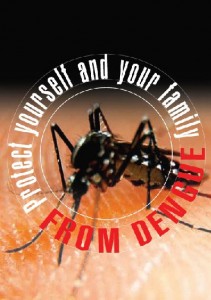One of the major health problems during rainy seasons is the incidence of Dengue Hemmoragic Fever. DENGUE is an acute infectious disease transmitted by Aedes aegypti, a day-biting mosquito which lays eggs in clear and stagnant water found in flower vases, cans, rain barrels, old rubber tires or any containers surrounding our homes.
The symptoms of dengue fever includes the following:
- Sudden onset of high fever which may last 2 to 7 days.
- Joint & muscle pain and pain behind the eyes.
- Weakness
- Skin rashes – maculopapular rash or red tiny spots on the skin called petechiae
- Nosebleeding when fever starts to subside
- Abdominal pain
- Vomiting of coffee-colored matter
- Dark-colored stools
 Dengue Hemmoragic Fever occurs in all age group. This disease is preventable but is prevalent in urban centers where population density is high and water supply, solid waste collection, and storage is inadequate
Dengue Hemmoragic Fever occurs in all age group. This disease is preventable but is prevalent in urban centers where population density is high and water supply, solid waste collection, and storage is inadequate
For over five months, a total of 6,537 cases of dengue, including 62 deaths, have been reported in the country. According to the Department of Health (DOH), they are continuing their efforts on controlling and preventing dengue – a disease for which there is currently no vaccine or specific drug.
With this challenge at hand, the government recently kicked off a nationwide anti-dengue campaign to educate the population on how to protect themselves. “The most important key to prevent and control diseases is empowering our people with correct information so that they can take steps to stop their transmission and limit the harm that they bring through proper and timely health-seeking behavior,” Duque, DOH Secretary said.
[tags]Dengue Fever, Dengue Hemmoragic Fever, Department of Health, DOH, Duque, Prevention, Cure, Symptoms, Aedis aegypti, cases of dengue in the Philippines, Batangas[/tags] WOWBatangas.com Your Source of Great News and Stories from the Province of Batangas, Philippines
WOWBatangas.com Your Source of Great News and Stories from the Province of Batangas, Philippines




This blog post receives a 2 thumbs up from me.